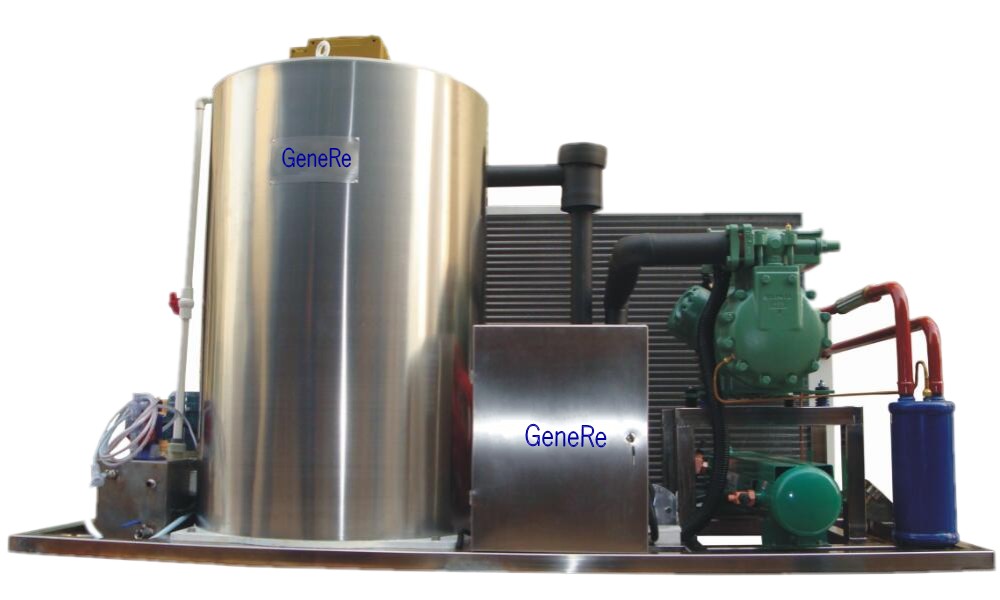Application Solutions Of Flake Ice Machine In Deep Processing Of Aquatic Products
Application Solutions Of Flake Ice Machine In Deep Processing Of Aquatic Products

The advantages of flake ice:
Large contact area and rapid cooling
Due to its flat shape, ice flake has a larger surface area than other shapes of ice of the same weight. The larger the contact surface area, the better the cooling effect. Taking comparison as an example, the minimum surface area of one ton of ice flake is 1579 square meters, and other types of ice such as tube ice and particle ice can only provide 395 to 1294 square meters. Therefore, the refrigeration efficiency of ice flake is 2 to 5 times higher than that of tube ice and cube ice.
Low production costs
The production cost of ice flake is very economical, and it only requires about 85 degrees Celsius of electricity to cool 16 degrees Celsius water into 1 ton of ice flake.
Excellent food preservation
The texture of the ice flake is dry, soft and without sharp edges, which can provide protection for the packaged food during the refrigeration packaging process. Its flat appearance will minimize the potential harm to the refrigerated item.
Thoroughly mixed
Due to the huge surface area of ice flake, its heat exchange process is rapid, and ice flake can quickly melt into water, taking away heat and increasing humidity for the mixture.
Convenient storage and transportation
Due to the dry texture of ice sheets, they are less prone to adhesion during low-temperature storage and spiral transportation, making them easier to store and transport.
The actual amount of ice used will vary with changes in water temperature and ambient temperature.
2. The standard power supply is 3PH-380V/50Hz.
3. The water source is fresh water, which can be ordinary tap water or groundwater.
4. The machine should be placed indoors.
The ice type produced by the machine is ice flake, with a thickness of 1.8-2.2mm.
6. Standard operating conditions: ambient temperature of 25 ℃, water temperature of 18-20 ℃.


Ice flakes are widely used in food processing, manufacturing, and concrete cooling and other fields.
Fisheries: Seawater ice machines can be directly installed on fishing boats and used to make ice from seawater. The salvaged seafood can be quickly frozen and preserved, and fishing is one of the main application areas of ice slicers worldwide.
Aquatic product processing: Ice flakes can lower the temperature of processing media, cleaning water, and aquatic products, prevent bacterial growth, and maintain freshness during the aquatic product processing.
Food processing: For example, in bread production, when stirring or re adding cream, use ice flakes to quickly cool down to prevent fermentation.
Poultry meat processing: During the processing of poultry and meat, a huge amount of heat is generated. Sliced ice can be used for the cooling process of poultry meat, while also regulating the humidity of the product to improve quality.
Vegetable distribution and preservation: Nowadays, in order to ensure the safe consumption of vegetables, fruits, and meat products, more and more physical methods are used to control temperature in product storage and transportation. Ice flakes have a rapid cooling effect, creating a low temperature and high humidity environment to ensure that the theme is not damaged by bacteria.
The pharmaceutical industry: In many biological and chemical synthesis experiments, a large amount of ice needs to be added to control the reaction rate and maintain the activity of the organism. Ice flakes are hygienic, clean, and have a fast cooling speed, making them the most ideal cooling carrier in the industry.
Concrete mixing: ice flake is directly used as the source of water in concrete mixing, with a maximum proportion of up to 80%. It can provide efficient and easy to control cooling effects. Concrete mixed at a constant temperature will not crack due to physical deformation caused by temperature, thus ensuring the quality and safety of the project. Ice concrete cooling systems are widely used in high-quality large-scale projects worldwide, such as large dams, high-grade highways, high-rise buildings, and nuclear power plant construction projects
Chemical dyes:
With the rapid development of the chemical product processing industry, the market's requirements for the quality and process of chemical products are constantly increasing. Due to the physical properties of ice, the application of ice in the chemical industry is constantly expanding. In the production and synthesis process of azo reactive pigments and dyes, diazotization, coupling, and condensation are necessary synthesis processes. Due to the release of a large amount of heat in diazotization, coupling, and condensation reactions, the ideal reaction conditions should be between 0-5 degrees Celsius. Therefore, a large amount of ice must be added for cooling during the chemical reaction process to control the temperature and ensure the quality of the product.
